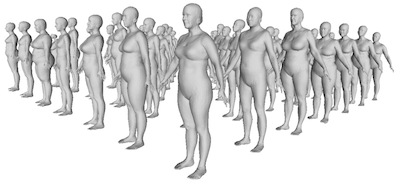Evaluating the Automated Alignment of 3D Human Body Scans
pdf
The statistical analysis of large corpora of human body scans requires that these scans be in alignment, either for a small set of key landmarks or densely for all the vertices in the scan. Existing techniques tend to rely on hand-placed landmarks or algorithms that extract landmarks from scans. The former is time consuming and subjective while the latter is error prone. Here we show that a model-based approach can align meshes automatically, producing alignment accuracy similar to that of previous methods that rely on many landmarks. Specifically, we align a low-resolution, artist-created template body mesh to many high-resolution laser scans. Our alignment procedure employs a robust iterative closest point method with a regularization that promotes smooth and locally rigid deformation of the template mesh. We evaluate our approach on 50 female body models from the CAESAR dataset that vary significantly in body shape. To make the method fully automatic, we define simple feature detectors for the head and ankles, which provide initial landmark locations. We find that, if body poses are fairly similar, as in CAESAR, the fully automated method provides dense alignments that enable statistical analysis and anthropometric measurement.
| Author(s): | Hirshberg, D. A. and Loper, M. and Rachlin, E. and Tsoli, A. and Weiss, A. and Corner, B. and Black, M. J. |
| Links: | |
| Book Title: | 2nd International Conference on 3D Body Scanning Technologies |
| Pages: | 76--86 |
| Year: | 2011 |
| Month: | October |
| Editors: | D{'}Apuzzo, Nicola |
| Publisher: | Hometrica Consulting |
| Project(s): | |
| Bibtex Type: | Conference Paper (inproceedings) |
| Address: | Lugano, Switzerland |
| DOI: | 10.15221/11.076 |
| Electronic Archiving: | grant_archive |
| Attachments: | |
BibTex
@inproceedings{Hirshberg:BST:11,
title = {Evaluating the Automated Alignment of {3D} Human Body Scans},
booktitle = {2nd International Conference on 3D Body Scanning Technologies},
abstract = {The statistical analysis of large corpora of human body scans requires that these scans be in alignment, either for a small set of key landmarks or densely for all the vertices in the scan. Existing techniques tend to rely on hand-placed landmarks or algorithms that extract landmarks from scans. The former is time consuming and subjective while the latter is error prone. Here we show that a model-based approach can align meshes automatically, producing alignment accuracy similar to that of previous methods that rely on many landmarks. Specifically, we align a low-resolution, artist-created template body mesh to many high-resolution laser scans. Our alignment procedure employs a robust iterative closest point method with a regularization that promotes smooth and locally rigid deformation of the template mesh. We evaluate our approach on 50 female body models from the CAESAR dataset that vary significantly in body shape. To make the method fully automatic, we define simple feature detectors for the head and ankles, which provide initial landmark locations. We find that, if body poses are fairly similar, as in CAESAR, the fully automated method provides dense alignments that enable statistical analysis and anthropometric measurement.},
pages = {76--86},
editors = {D{'}Apuzzo, Nicola},
publisher = {Hometrica Consulting},
address = {Lugano, Switzerland},
month = oct,
year = {2011},
slug = {hirshberg-bst-11},
author = {Hirshberg, D. A. and Loper, M. and Rachlin, E. and Tsoli, A. and Weiss, A. and Corner, B. and Black, M. J.},
month_numeric = {10}
}




